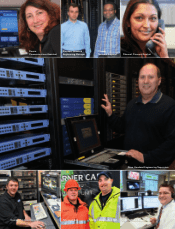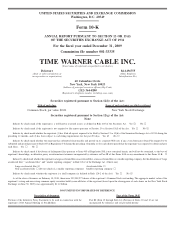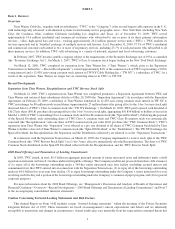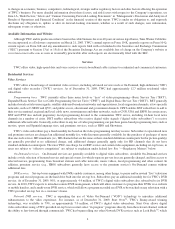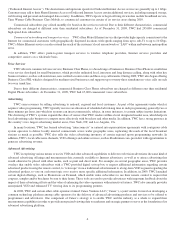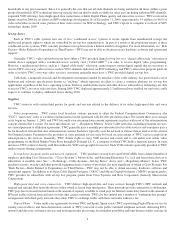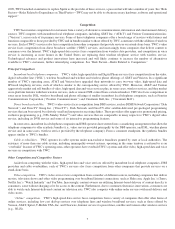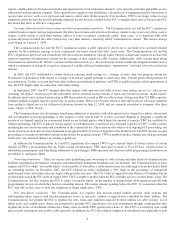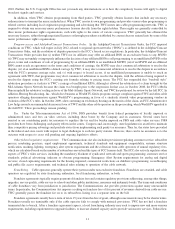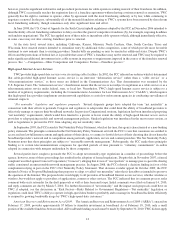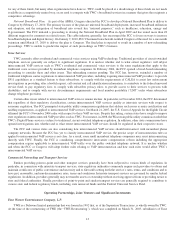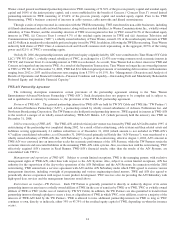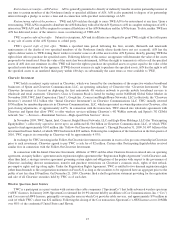Time Warner Cable 2009 Annual Report Download - page 18
Download and view the complete annual report
Please find page 18 of the 2009 Time Warner Cable annual report below. You can navigate through the pages in the report by either clicking on the pages listed below, or by using the keyword search tool below to find specific information within the annual report.households at any given moment. Since it is generally the case that not all such channels are being watched at all times within a given
group of households, SDV technology frees up capacity that can then be made available for other uses, including additional HD channels,
expanded VOD offerings, faster high-speed data connections, reliable Digital Phone quality and interactive services. TWC received an
Emmy award in 2008 for its efforts in SDV technology development. As of December 31, 2009, approximately 5.9 million (or 46%) of
video subscribers received some portion of their video service via SDV technology, and TWC expects to complete its roll-out of SDV
technology during 2010.
Set-top Boxes
Each of TWC’s cable systems uses one of two “conditional access” systems to secure signals from unauthorized receipt, the
intellectual property rights to which are controlled by set-top box manufacturers. In part as a result of the proprietary nature of these
conditional access systems, TWC currently purchases set-top boxes from a limited number of suppliers. For more information, see “Risk
Factors—Risks Related to Dependence on Third Parties—TWC may not be able to obtain necessary hardware, software and operational
support.”
Generally, TWC’s video subscribers must have either a TWC-provided digital set-top box or a “digital cable-ready” television or
similar device equipped with a conditional-access security card (“CableCARD
TM
”) in order to receive digital video programming.
However, a unidirectional device, such as a “digital cable-ready” television, cannot request certain digital signals that are necessary to
receive TWC’s two-way video services, such as VOD, channels delivered via SDV technology and TWC’s interactive program guide. In
order to receive TWC’s two-way video services, customers generally must have a TWC-provided digital set-top box.
CableLabs, a nonprofit research and development consortium founded by members of the cable industry, has put forward a set of
hardware and software specifications known as “tru2way,” which represent an effort to create a common platform for set-top box
applications regardless of the box’s operating system. Tru2way-enabled televisions and other devices with tru2way technology are able
to receive TWC’s two-way video services. During 2009, TWC deployed approximately 2.3 million tru2way-enabled set-top boxes, and it
expects to continue to deploy additional boxes during 2010.
Suppliers
TWC contracts with certain third parties for goods and services related to the delivery of its video, high-speed data and voice
services.
Video programming. TWC carries local broadcast stations pursuant to either the Federal Communications Commission (the
“FCC”) “must carry” rules or a written retransmission consent agreement with the relevant station owner. The current three-year carriage
cycle began on January 1, 2009, and TWC has multi-year retransmission consent agreements in place with most of the retransmission
consent stations that it carries. For more information, see “—Regulatory Matters” below. Cable networks, including premium services,
are carried pursuant to affiliation agreements. TWC generally pays a monthly per subscriber fee for cable services and sometimes pays a
fee for broadcast stations that elect retransmission consent. Such fees typically cover the network or station’s linear feed as well as its free
On-Demand content. Payments to the providers of some premium services may be based on a percentage of TWC’s gross receipts from
subscriptions to the services. Generally, TWC obtains rights to carry VOD movies and events and to sell and/or rent online video
programming via the Road Runner Video Store through iN Demand L.L.C., a company in which TWC holds a minority interest. In some
instances, TWC contracts directly with film studios for VOD carriage rights for movies. Such VOD content is generally provided to TWC
under revenue-sharing arrangements.
Set-top boxes, program guides and network equipment. TWC purchases set-top boxes and CableCARDs from a limited number of
suppliers, including Cisco Systems Inc. (“Cisco Systems”), Motorola Inc. and Samsung Electronics Co., Ltd. and leases these devices to
subscribers at monthly rates. See “—Technology—Cable Systems—Set-top Boxes” above and “—Regulatory Matters” below. TWC
purchases routers, switches and other network equipment from a variety of providers, the most significant of which is Cisco Systems. See
“Risk Factors—Risks Related to Dependence on Third Parties—TWC may not be able to obtain necessary hardware, software and
operational support.” In addition to its Open Cable Digital Navigator (“ODN”) and Mystro Digital Navigator (“MDN”) program guides,
TWC provides its subscribers with set-top box program guides from Cisco Systems and Rovi Corporation (formerly Macrovision
Corporation).
High-speed data and voice connectivity. TWC delivers high-speed data and voice services through TWC’s HFC network and
regional and national fiber networks that are either owned or leased from third parties. These networks provide connectivity to the Internet.
TWC pays fees for leased circuits based on the amount of capacity available to it and pays for Internet connectivity based on the amount of
IP-based traffic received from and sent over the other carrier’s network. TWC also has entered into a number of “settlement-free peering”
arrangements with third-party networks that allow TWC to exchange traffic with those networks without a fee.
Digital Phone. Under multi-year agreements between TWC and Sprint, Sprint assists TWC in providing Digital Phone service by
routing voice traffic to and from destinations outside of TWC’s network via the public switched telephone network, delivering E911,
operator and directory assistance services and assisting in order processing, local number portability and long-distance traffic carriage. In
6



